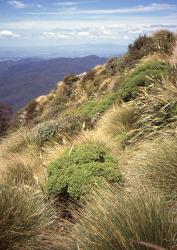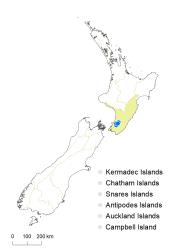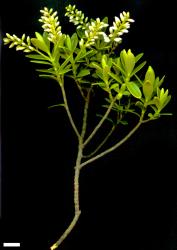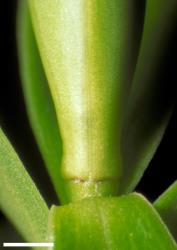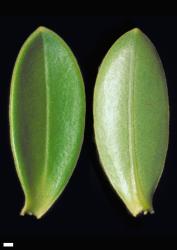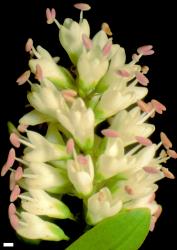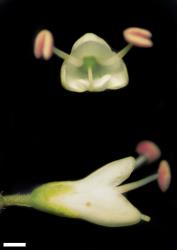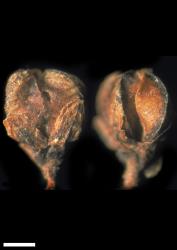- ≡ Hebe evenosa (Petrie) Cockayne & Allan, Trans. New Zealand Inst. 57: 29 (1926)
Rounded shrub to 2 m tall. Stems erect, hairs eglandular-pubescent; hairs uniform to bifarious. Leaf bud distinct, its leaves appressed at margins until fully grown; sinus absent. Leaves opposite-decussate, erecto-patent to spreading, or recurved with age; lamina sub-coriaceous, elliptic, obovate, or oblanceolate, 12–28 mm long, 4–9 mm wide, glossy green above, dull or glossy pale green beneath; midrib evident; surfaces glabrous or with eglandular hairs along midrib above; margin ciliolate, entire, cartilaginous; apex usually obtuse or sub-acute or shortly plicate-acuminate; base cuneate; petiole indistinct, 1–2 mm long. Inflorescence a lateral raceme, 14–50 mm long; flowers crowded,15–40, female or bisexual on separate plants, ⚥ > ♀; bracts alternate, narrowly deltoid to lanceolate or elliptic, slightly < to = pedicels; pedicels erecto-patent, 0.5–3.3 mm long, eglandular-pubescent all around. Calyx lobes 4–5 (5th small, posterior), obtuse or sub-acute, 1.5–2.0 mm long, sub-equal, mixed glandular- and eglandular-ciliolate. Corolla 5–8 mm diameter (⚥ similar to ♀); tube white, 1.5–2.0 mm long, < (♀) to = (⚥) calyx, eglandular-hairy inside; lobes 4, white, sub-erect to erecto-patent, recurved with age, sub-equal, rhomboid to ovate or elliptic, 3–4 mm long, obtuse; nectar guides absent. Stamen filaments white, 2.5–5.0 mm long; anthers pink or pale purplish. Style glabrous, 3.0–7.2 mm long. Capsules latiseptate, obtuse, glabrous, 3–3.7 mm long, 3–4 mm at widest point. Seeds discoid to ellipsoid, flattened, smooth, brown, 1.2–1.5 mm long.
Veronica evenosa is one of a group of species characterised by neat, rounded habit, small leaves, no sinus in the vegetative bud, and short, rounded corolla lobes. Only one other such species, V. truncatula, also occurs in the North Island; it is distinguished by larger and more lanceolate leaves, longer inflorescences with up to 68 flowers, and by chromosome number and flavonoid chemistry. V. truncatula plants have no or few stomata on the upper leaf surface, whereas V. evenosa plants have many, and V. truncatula inflorescences tend to be longer, with more flowers.
Two species from the South Island, V. topiaria and V. urvilleana, are very similar and might be related to V. evenosa. They share high chromosome numbers (2n = 120 in V. evenosa and V. urvilleana; 2n = 122 in V. topiaria). V. urvilleana plants have leaves that are more narrowly acute at the apex and more tapered to the base, and capsules that are only shortly loculicidal. V. topiaria plants have dull, glaucous leaves.
North Island: Southern North Island (Tararua Range: Mt Dennan, Mt Holdsworth, Mt Mitre).
An additional record extends the northern limit to Herepai, about 12 km north of Mt Mitre, but this is supported by only a photograph and has not been mapped.
Sub-alpine scrub around tree line. Recorded elevations range from 915 to 1279 m.
Flowers: January–February; fruits: February–April, sometimes to June.
2n = 120 (see Bayly & Kellow 2006, as Hebe evenosa).
Veronica evenosa is classified in V. subg. Pseudoveronica sect. Hebe and the informal group “Occlusae” (Albach & Meudt 2010; Bayly & Kellow 2006).
So far, DNA data have not been able to resolve the closest relatives of V. evenosa. However, it has similarities of habit, morphology, and chromosome number to V. topiaria and V. urvilleana.



